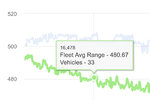So, I had 3 questions about the Teslafi chart:
• When I look at your data, I see 3 sections, the original flat section up to 39k, representing about 503k original range; then a current flat section from 52k onward, representing about 493k. Then, there's the gradual but steady drop from 39k to 52k. Any externalities that you can think of contributing to that drop?
View attachment 927150
• Two, that light green line represents only 4 other vehicles? Does that imply that there isn't a lot of datapoints in the Teslafi database?
• Three, your data, when compared to the "fleet" isn't included in the "fleet"?
1) original range was 507km. Teslafi calculates it by taking current range divided by SOC. As the SOC is rounded to whole numbers when teslafi gets it the teslafi calculated range jumps around about 5-10km and the highest values are still a little shy of the range I see at full charge.
During the first line/part you did mark, I always did see 507km at the full charges.
Scan my tesla also reported the full rated range to about 507 km during this time.
Despite the varying “Estimated 100% range” we see here, the Nominal full pack has been 78.8-78.9 during all this time.
The drop at about 39K was induced by me, or at least I think so. I tried a reversed BMS-calibration at that time. I still had a nominal full pack of 81.4kWh (steady for months) which was not really credible after > 1 year and 39 K km. So I did run the car down to very low SOC, twice (-1.8% and -2%) as driving down to 0% had not helped. After this the NFP started to move. At this time I had my own calculation/estimation about the battery capacity (circa 79kWh) but when the NFP started the move down it went progressively all the way down to 75.7kWh. At the same time (more or less precisely) I made a 100-0% drive that indicated 78.85-79kWh capacity, so I can safely say that that was the BMS being as much if on the low side, as it was “high” before that.
I did not do any BMS calibration stuff, I just used the car and eventually it came up to 78.6-78.9 where it has been for a while.
Currently it looks like the BMS is “on track” as it doesnt adjust the SOC noticably after a long drive + sleep.
As the BMS was “stuck hi” the true range has not been shown that often in my car.
I made a hand drawn line with my mobile phone, so it is not that exact, but just to show how the real range should have looked. IRL, I probably had >80.6 kWh for the first six months or so it should be at 507 km for about 10-15K and then reduce, but I think you get the idea if how the battery actually degraded from that picture.
2) The “number of other cars” is cars that have a logged charge with the same odo reading (must be a quite narrow band used, as this number go up and down each day).
There is at least 33 or so M3P facelift/2021, that can ve seem at lower odo readings. As the ”band is narrow” there probably is much more, like the double amount or so in total. My car is included in the average, as it seems. Scrolling through gives a very varying number of cars, like 20-33, the number jumps up and down. As most cars havent the same miles as my, there is fewer cars close to 60K km.

3) The latest part of the average line jumps between 2 and 8 cars.




